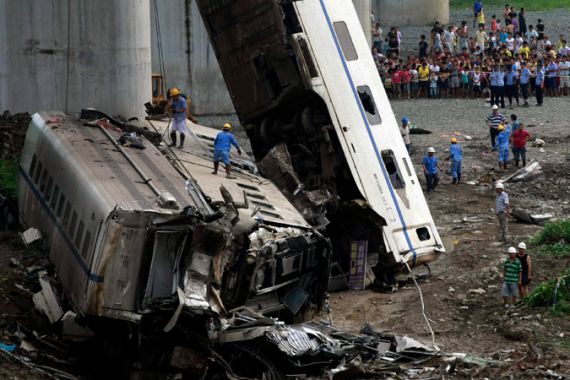Unsafe at any speed?
China has applied for patents for its high-speed trains, but the technology may have been pirated from the Japanese.

 |
|
The CRH380A bullet train relies on technology from a Japanese company, Kawasaki Heavy Industries [GALLO/GETTY] |
At least 38 people were killed and more than 200 injured by the recent crash of two high-speed trains near Zhenzhou in Zhejiang, a province in China. The wrecked body of the ruined train was buried immediately afterward, with no investigation.
The intellectual property dispute between Japan and China over the technology used in China’s new bullet trains was heated even before the accident. In the wake of the crash, the dispute has come to a boil.
Japan, of course, was the first country to build “bullet” trains, and their safety record is enviable. The Shinkansen super bullet train, which was directly affected by the earthquake that devastated northeast Japan in March, was able to resume operations on April 29. The latest model Japanese bullet train, the Hayabusa, which made its debut only a week before the earthquake, can operate at 320 kilometres (200 miles) an hour – and now does, following quick repairs to its line.
Since it began operating between Tokyo and Shin-Osaka in 1964, Japan’s Shinkansen has served as a vital transport artery in Japan, and has suffered no fatal accidents. Let me reiterate: not a single person has died in a Shinkansen accident. The automatic train-stop system, perfected for the Shinkansen, functioned flawlessly even during the earthquake.
Despite its technological lead and enviable record, Shinkansen trains were not exported overseas for decades. The first such technology transfer was the Taiwan High Speed Rail (THSR), which began operating in January 2001. THSR connects Taipei and Kaohsiung, which are 345 kilometres (214 miles) apart, in 90 minutes. As a result of a renewed emphasis on safety following an earthquake, the Taiwanese authorities decided to use Japanese technology for the rolling stock and a mixture of German and French technology for other facilities and operations.
Today, the great stage for the Shinkansen is China’s vast territory, where economic development continues at a stunning rate. On June 30, the Beijing-Shanghai High-Speed Railway, covering the 1,318 kilometres (819 miles) between China’s two most important cities at approximately 300 kilometres (185 miles) an hour, began operating, timed to celebrate the 90th anniversary of the founding of the Communist Party of China. The rolling stock for China’s CRH380A bullet train is based on technology from Kawasaki Heavy Industries, whereas the German company Siemens provided the technology for the CRH380B.
One reason why Japan hesitated to export its high-speed rail technology was revealed by JR Tokai Chairman Takayuki Kasai, who wanted to make its provision conditional upon the “country being politically stable and governed by the rule of law”. He regularly highlighted the importance of compliance with enforceable contracts that would guarantee intellectual property rights.
With these reservations in mind, JR East Japan proceeded with the export of Shinkansen technology to China. Unfortunately, Kasai’s fears have been vindicated. Immediately before the Beijing-Shanghai railway was built, the Chinese Ministry for Railways initiated international patent claims concerning the technology used in the CRH380A. It is believed that China has now filed for 21 patents in accordance with the Patent Cooperation Treaty (PCT), with the aim of obtaining patents in Japan, the United States, Brazil, Europe, and Russia.
Since 2003, China has filed for 1,902 patents related to high-speed railways, with 1,421 approved and 481 still being examined. But the 21 recent applications are the first based upon Japanese Shinkansen technology.
It has been reported that these patent applications are for the technology used in the carriage’s chassis and also for the front end of the lead carriage. The originality remains unknown for now, because the content of the patent application will not become clear until the 18 months required for investigating prior art has elapsed. But there is a strong view that the technology is an extension of that provided by either Japan or Germany, and the case could well lead to a major intellectual property dispute.
Infringement of intellectual property rights by China is one of the most vexing aspects of trade with the Chinese. For example, a Chinese animation called “Train Hero” received much criticism in Chinese internet circles when it was found to be nearly identical to the popular Japanese animation called “Japan Hikarian Railroad”. Not only was the story the same, but it even took shortcuts, such as having characters eat onigiri rice balls, a Japanese food not eaten in China. As a result, Chinese state television cancelled a broadcast scheduled for August.
The market for Shinkansen technology is growing not only in China, but also in the US – where the state of California wants to build such a system – and in emerging-market countries such as Brazil. With demand extremely large, international competition to construct high-speed railway networks is becoming intense, as the lobbying for the California contract demonstrates. And this competition concerns not only the level of technology and speed, but also of safety.
So long as protection of intellectual property rights in China is woefully inadequate, the high-speed rail market is likely to remain riddled with heated disputes. In China, the rush to apply for patents is sometimes said to be about saving face with ordinary Chinese, who might well object to buying technology from abroad when China’s government so often lauds homegrown technology. But China will lose even more face if it is shown to have pirated the Shinkansen technologies that it now claims as its own.
Yuriko Koike, Japan’s former Minister of Defence and National Security Advisor, is Chairman of the Executive Council of the Liberal Democratic Party.
A version of this article was first published by Project Syndicate.
The views expressed in this article are the author’s own and do not necessarily reflect Al Jazeera’s editorial policy.
